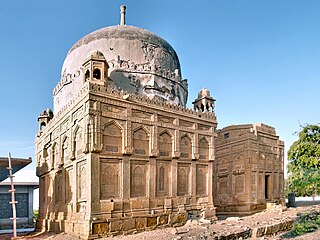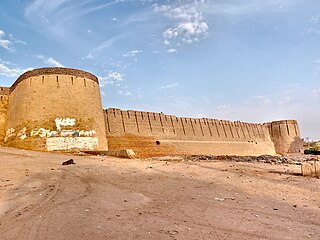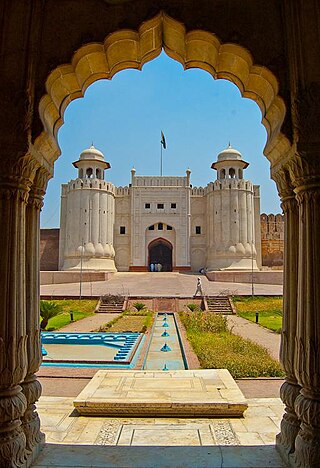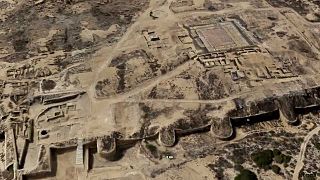
The Districts of Pakistan are the third-order administrative divisions of Pakistan, below provinces and divisions, but forming the first-tier of local government. In total, there are 170 districts in Pakistan including the Capital Territory and the districts of Azad Kashmir and Gilgit Baltistan. These districts are further divided into Tehsils, Union Councils.

Mirpur Khas is the capital city of the Mirpur Khas District and Mirpur Khas Division in the Sindh province, Pakistan. Mirpur Khas is the 6th largest city in Sindh province and the 34th largest city of Pakistan. The city was built by Talpur rulers of Mankani branch. According to the 2017 Census of Pakistan, its population is 233,916. Mirpur Khas is known for its mango cultivation, with hundreds of varieties of the fruit produced each year - it is also called the “City of Mangoes,” and has been home to an annual mango festival since 1955. After the completion of Hyderabad-Mirpurkhas dual carriage way, the city has become hub of commercial activities.

Umerkot is a city in the Sindh province of Pakistan. The 3rd Mughal emperor Akbar was born at Umerkot in 1542.

Umerkot District, also known as Amarkot District, is a district in the Sindh province of Pakistan. The city of Umerkot is the capital of the district. Sindhi is the native language of approximately 93.4% of the residents according to the 2017 Pakistan Census. Umerkot is the only non-Muslim majority district in Pakistan, with adherents of Hinduism representing 52.2% of the total population.

Tourism in Pakistan is a growing industry. In 2010, Lonely Planet termed Pakistan "tourism's 'next big thing'". The country is geographically and ethnically diverse, and has a number of historical and cultural heritage sites. Condé Nast Traveller ranked Pakistan The Best Holiday Destination for 2020 and also declared it the third-highest potential adventure destination in the world for 2020. As security in the country improves, tourism increases; in two years, it has increased by more than 300%. The Pakistani government had launched online visa services for 175 countries and 50 countries were offered visa on arrival, making visiting Pakistan easier. The country received an influx of travel vloggers, who promoted the characteristics of the country, such as in the Northern Pakistan, like Hunza and Skardu.
Pakistani architecture is intertwined with the architecture of the broader Indian subcontinent. The major architectural styles popular in the past were Temple, Indo-Islamic, Mughal and Indo-Saracenic architecture, all of which have many regional varieties. With the beginning of the Indus civilization around the middle of the 3rd millennium BC, for the first time in the area which encompasses today's Pakistan an advanced urban culture developed with large structural facilities, some of which survive to this day. This was followed by the Gandhara style of Buddhist architecture that borrowed elements from Ancient Greece. These remnants are visible in the Gandhara capital of Taxila.

Sindh is a province in Pakistan.

The Sindh Museum is a museum located in Hyderabad, Sindh, Pakistan. The museum was established in 1971 to collect, preserve, study, and exhibit the records of the cultural history of Sindh. It also sometimes hosts cultural fairs.

Umarkot Fort, is a fort located in Umerkot, Sindh, also called Amarkot, Umerkot was founded and ruled By Sodha Rajputs of Parmar Dynasty. It was named after its founder Rana Amar Singh Sodha. Emperor Akbar was born in Umarkot Fort when his father Humayun fled from the military defeats at the hands of Sher Shah Suri on 15 October 1542. Rana Prasad Singh Sodha of Umarkot, who had risen to power, had given refuge to Mughal Emperor Humayun, and it was there Hamida Bano Begum gave birth to young Akbar. Later the Mughal Emperor Akbar became the Shahenshah of Hindustan and was a popular figure with both Hindus and Muslims. Umerkot has many sites of historical significance such as Mughal emperor Akbar's birthplace near to Umarkot Fort. Currently, King Akbar birthplace is an open land. In 1746, the Mughal Subahdar, Noor Mohammad Kalhoro, built a fort at the location. Later the British took over that area.

Bhit Shah Museum is a museum in Bhit Shah in the Matiari District of Sindh in southeast Pakistan. It depicts various aspects of Shah Abdul Latif Bhittai's poetry. The museum was set up as a sister organization of the Bhit Shah Cultural Centre. It is frequented by people visiting the shrine nearby.

Banbhore, Bambhore, Bhanbhore or Bhambhore is a city dating to the 1st century BCE located in modern-day Sindh, Pakistan. The city ruins lie on the N-5 National Highway, east of Karachi. It dates back to the Scytho-Parthian era and was later controlled by Muslims from the 8th to the 13th century, after which it was abandoned. Remains of one of the earliest known mosques in the region dating back to 727 AD are still preserved in the city. In 2004, Department of Archaeology and Museums Pakistan submitted the site for UNESCO World Heritage Sites.

Punjab is the largest province in population and the second largest province in physical size in Pakistan. In 2017, 1.75 million tourists visited Pakistan according to the World Travel and Tourism Council.
Khokhropar Railway Station, also called Khokhrapar Railway Station, is located in Khokhrapar town, Sindh, Pakistan. This railway station, 70 km from Umerkot, was established in the late 19th century as the first railway station in Sindh on the India-Pakistan border. The valley comprises today's Sanghar, Mirpurkhas, Tharparkar and Umerkot districts. Rice and other grains were produced in huge quantity in the area. The people of Rajasthan used to travel to and from Khokhrapar railway station in a train called Raja-ji-Rail. It was called so because the Raja of Jodhpur and other Rajas of neighbouring princely states helped Indian Railways to lay down a 650-km meter-gauge track from Jodhpur to Hyderabad.

PS-51 Umerkot-III is a constituency of the Provincial Assembly of Sindh.

PS-50 Umerkot-II is a constituency of the Provincial Assembly of Sindh.

PS-49 Umerkot-I is a constituency of the Provincial Assembly of Sindh.
Sodha is a Rajput clan residing in India and Pakistan.

Sehwan Fort, known locally as Ulti Basti, is a ruined fort situated in Sehwan, Sindh, Pakistan.















